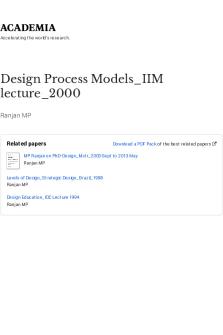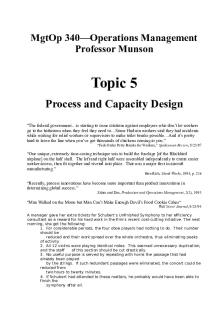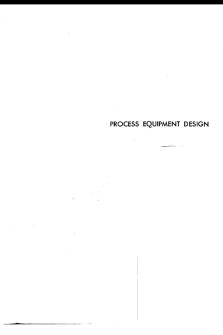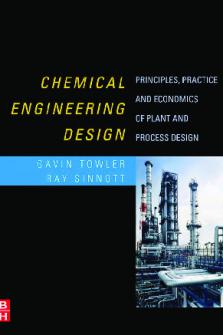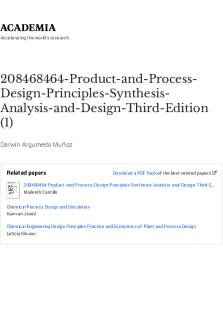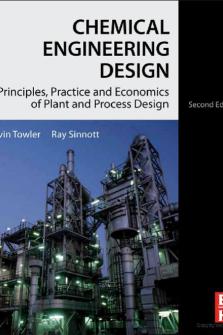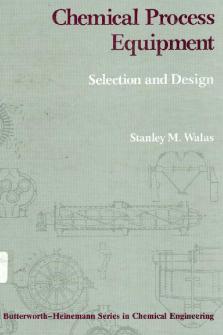CH3-Product and Process Design PDF

| Title | CH3-Product and Process Design |
|---|---|
| Author | christian arante |
| Course | Bachelor of Science in Accountancy |
| Institution | Polytechnic University of the Philippines |
| Pages | 29 |
| File Size | 710.3 KB |
| File Type | |
| Total Downloads | 38 |
| Total Views | 157 |
Summary
For POM...
Description
File: ch03, Chapter 3: Product and Process Design
Multiple Choice
1. The ease with which the product can be made is its b) repeatability c) readiness for manufacturing d) reliability e) accountability Ans: a Section Ref: Product Design Level: moderate
2. Service design differs from product design by including __________________________. a) customer needs b) marketing personnel in the decision making process c) speed d) quality Ans: e Section Ref: Product Design Level: moderate
3. A company’s product design supports it business strategies by b) designing as many products as possible c) including the company’s mission somewhere in the product d) designing products that aid strategic planning activities e) designing the company’s strategy Ans: a Section Ref: Product Design Level: hard
4. Which of the following is not a step in product design? a) final design b) preliminary design and testing c) idea development
e) product screening Ans: d Section Ref: The Product Design Process Level: moderate
5. ___________ is a vital link between customers and product design. a) Engineering b) Accounting c) The Internet d) Operations
Ans: e Section Ref: The Product Design Process Level: moderate
6. All product designs begin with ____________________________. a) a blueprint b) a cost analysis d) a feasibility study e) a focus group Ans: c Section Ref: The Product Design Process Level: moderate
7. Which of the following is true regarding the relative predictability of the cycle of new product introductions? a) new car models are predictable, but new fashion and new skin care products are not c) new car models, new fashion, and new skin care products are all predictable d) new car models, new fashion, and new skin care products are all unpredictable e) new fashion and new skin care products are predictable, but new car models are not Ans: b Section Ref: The Product Design Process Level: hard
8. Lands’ End is a well known benchmarking target because of its _________________________.
b) supply chain management c) success at resolving complaints d) labor relations e) environmental policies Ans: a Section Ref: The Product Design Process Level: hard
9. In 1997, who performed a large benchmarking study for IBM? a) Boston Consulting Group b) Anderson Consulting c) i2 Technologies e) Manugistics Ans: d Section Ref: The Product Design Process Level: hard
10. When designing the Taurus model, what did Ford Motor Company do with regard to BMW and Toyota? a) benchmarking b) hired some of their employees d) copied their quality management techniques e) bought some of their dealerships Ans: c Section Ref: The Product Design Process Level: hard
11. Reverse engineering is: a) altering the basic design based on user input. b) reengineering a failing product. c) acquiring a competitor’s product and relabeling it for sale. e) changing your mind on the previous design. Ans: d Section Ref: The Product Design Process Level: moderate
12. Studying the practices of companies considered ―best in class‖ and comparing the performance of our company against their performance is a) competition b) copying c) frustration e) notching Ans: d Section Ref: The Product Design Process Level: moderate
13. Involving suppliers early in the design process is called: a) reengineering b) disaggregation c) redesign d) benchmarking Ans: e Section Ref: The Product Design Process Level: moderate
14. Evaluating a product idea to determine its likelihood of success is b) estimating c) technological forecasting d) product windowing e) product evolution Ans: a Section Ref: The Product Design Process Level: moderate
15. In product screening, issues such as ―Will we need new facilities and equipment?‖ and ―Can material for production be readily obtained?‖ are addressed by a) marketing b) finance c) engineering e) accounting Ans: d Section Ref: The Product Design Process
Level: moderate
16. In product screening, issues such as, ―What is the market size?‖ and ―What is the long termproduct potential?‖ are addressed by: b) finance c) engineering d) operations e) accounting Ans: a Section Ref: The Product Design Process Level: moderate
17. Approximately what percentage of ideas do not make it past the screening stage? a) 30% b) 50% c) 60% e) 90% Ans: d Section Ref: The Product Design Process Level: hard
18. What technique is based on computing the quantity of goods a company needs to sell to just cover its costs? a) net present value c) internal rate of return d) activity based costing e) variable costing Ans: b Section Ref: The Product Design Process Level: easy
19. Costs that are proportional to the amount of units produced, such as materials and labor, are a) fixed costs b) marginal revenue c) sunk costs d) cost drivers
Ans: e Section Ref: The Product Design Process Level: easy
20. Which of the following is not a fixed cost? a) land rent c) overhead d) taxes e) insurance Ans: b Section Ref: The Product Design Process Level: moderate
21. In break-even analysis, what is the break-even point? b) the quantity where revenue equals fixed cost c) the quantity where revenue equals variable cost d) the quantity beyond which the firm starts to lose money e) the quantity where variable cost equals fixed cost Ans: a Section Ref: The Product Design Process Level: moderate
22. In break-even analysis, in order to make a profit the company must b) sell below the break-even point c) sell at a loss d) sell at the break-even point e) sell on consignment Ans: a Section Ref: The Product Design Process Level: easy
23. For which of the following is break-even analysis not appropriate? a) deciding how much of a product must be sold to make a profit b) evaluating different processes c) deciding whether it is better to make or buy a product d) deciding between different products
Ans: e Section Ref: The Product Design Process Level: moderate
24. Which of the following is not included in the preliminary design and testing stage? b) design engineers translate general performance specifications into technical specifications c) ―bugs‖ are worked out d) revising the design based on test results e) prototypes are built and tested Ans: a Section Ref: The Product Design Process Level: moderate
25. During the final design and testing stage: a) the product design idea is evaluated according to the needs of the major business functions. b) design engineers hand the product over to the final design engineers. d) marketing becomes involved for the first time. e) the product achieves full production. Ans: c Section Ref: The Product Design Process Level: moderate
26. Which one of these refers to reducing the number of parts and features of the product whenever possible? a) design automation b) design specification c) design reduction d) design standardization Ans: e Section Ref: Factors Impacting Product Design Level: moderate
27. What refers to the use of common and interchangeable parts? a) design automation b) design specification
c) design reduction e) design simplification Ans: d Section Ref: Factors Impacting Product Design Level: moderate
28. Which of the following is not a guideline for design for manufacture? a) use modular design b) design parts for different products c) minimize parts e) simplify operations Ans: d Section Ref: Factors Impacting Product Design Level: hard
29. Maturity and decline are also referred to as: a) the early stages b) the life cycle d) design for manufacture stages e) re-engineering stages Ans: c Section The Product Design Process Level: Moderate
30. Which type of operation is used to produce many different products with varying process requirements in lower volumes? b) repetitive c) continuous d) downstream e) gateway Ans: a Section Ref: Process Selection Level: moderate
31. Which of the following is not characteristic of intermittent operations?
a) produce many different products with varying processing requirements c) workers need to be able to perform different tasks depending on the processing needs of the product d) general purpose equipment e) volume of goods produced directly tied to number of customer orders Ans: b Section Ref: Process Selection Level: moderate
32. Building a bridge over the Mississippi River for a new highway uses a b) batch process c) line process d) continuous process e) recycle process Ans: a Section Ref: Process Selection Level: moderate
33. The classes that you are taking at the university use a _______________ process. a) project c) line d) continuous e) recycle Ans: b Section Ref: Process Selection Level: moderate
34. What type of process is designed to produce a large volume of a standardized product for mass production, such as automobiles? a) project processes b) batch processes d) continuous processes e) recycle processes Ans: c Section Ref: Process Selection Level: moderate
35. Which type of process would be least likely to produce goods for inventory rather than for a specific customer request? b) batch c) line d) continuous e) remanufacturing Ans: a Section Ref: Process Selection Level: moderate
36. Which of the following is a tool for evaluating an operation in terms of the sequence of steps from inputs to outputs with the goal of improving its design. a) operations analysis b) operations sequencing d) input/output analysis e) sequencing analysis Ans: c Section Ref: Designing Processes Level: moderate
37. If the third stage of a repetitive line process cannot complete its activities as fast as stage one or two it has become a: a) key work location c) place not to work d) project process location e) none of these Ans: b Section Ref: Designing Processes Level: Moderate
38. Which of the following is correct sequence for relating product design, process selection, and arrangement of equipment in the factory? a) product design determines arrangement of equipment which determines process selection c) process selection determines product design which determines arrangement of equipment d) process selection determines arrangement of equipment which determines product design e) arrangement of equipment determines process selection which determines product design
Ans: b Section Ref: Linking Product Design and Process Selection Level: moderate
39. What type of operations focus on products in the early stage of the life cycle? a) repetitive b) downstream c) gateway e) recycle Ans: d Section Ref: Linking Product Design and Process Selection Level: moderate
40. With respect to competitive priorities, intermittent operations compete more on _______________ compared to repetitive operations. a) cost and features b) durability and cost c) availability and reliability e) durability and features Ans: d Section Ref: Linking Product Design and Process Selection Level: moderate
41. Intermittent operations group their resources based on a) requirements of the product c) shape of the shop floor d) abilities of the labor force e) the number of machines Ans: b Section Ref: Linking Product Design and Process Selection Level: moderate
42. Compared to intermittent operations, repetitive operations a) have higher material handling costs c) have slower processing rates
d) have more flexibility e) are less specialized Ans: b Section Ref: Linking Product Design and Process Selection Level: moderate
43. Which product and service strategy is used to produce standard components that can be combined to customer specifications? a) assemble-to-deliver b) make-to-stock d) make-to-order e) make-to-package Ans: c Section Ref: Linking Product Design and Process Selection Level: easy
44. Which product and service strategy has the longest delivery lead time? a) assemble-to-deliver b) make-to-stock c) assemble-to-order e) make-to-package Ans: d Section Ref: Linking Product Design and Process Selection Level: moderate
45. Pre-fabricated furniture with choices of fabric colors is an example of which product and service strategy? a) assemble-to-deliver b) make-to-stock d) make-to-order e) make-to-package Ans: c Section Ref: Linking Product Design and Process Selection Level: moderate
46. Which product and service strategy is typically seen in repetitive operations?
a) assemble-to-deliver c) assemble-to-order d) make-to-order e) make-to-package Ans: b Section Ref: Linking Product Design and Process Selection Level: moderate
47. If a firm’s facility layout is not correct it will create: a) project processes b) optimum outputs c) equal number of products e) job satisfaction Ans: d Section Ref: Linking Product Design and Process Selection Level: Moderate
48. Information Technology does NOT assist the firm in: a) information storage b) information processing d) intra firm information communication e) inter firm information communication Ans: c Section Ref: Technology Decisions Level: Easy
49. Vertical integration is a good strategic option for a manufacturing company when a) it needs several different parts and subassemblies b) it makes many different products c) its facilities are obsolete d) it uses distributed processing
Ans: e Section Ref: Technology Decisions Level: moderate
50. Which of the following is a disadvantage of automation? b) inconsistency of products c) inefficiency for producing large volumes d) harder to monitor quality e) frequent interruptions of production Ans: a Section Ref: Technology Decisions Level: hard
51. What is a small battery-driven truck that is not operated by a human and moves material from location to location? a) CAD c) AS/RS d) FMS e) CAM Ans: b Section Ref: Technology Decisions Level: moderate
52. A technology which uses sensor tags to monitor perishable products is: a) FMS b) CAD d) CAM e) RF Ans: c Section Ref: Technology Decisions Level: Hard
53. What is an automated material handling system that basically is an automated warehouse? a) CAD b) AGV d) FMS e) CAM Ans: c Section Ref: Technology Decisions Level: moderate
54. What is CAD short for? a) conceptually appropriate design c) commercial applications design d) competitive advantage design e) completely automated design Ans: b Section Ref: Technology Decisions Level: moderate
55. What is a type of automation system that provides the flexibility of intermittent operations with the efficiency of repetitive operations? a) CAD b) AGV c) AS/RS e) CAM Ans: d Section Ref: Technology Decisions Level: moderate
56. In manufacturing, a robot typically: a) resembles a human in appearance c) is mobile d) has legs e) is very small Ans: b Section Ref: Technology Decisions Level: moderate
57. What type of machine is controlled by a computer and can do a variety of tasks, such as drilling, boring, or turning parts of different sizes and shapes? b) variable turning c) flexible driven d) noncalculating e) next component Ans: a
Section Ref: Technology Decisions Level: moderate
58. What term is used to describe the integration of product design, process planning, and manufacturing using an integrated computer system? a) CAD/CAM b) AGV c) AS/RS d) FMS Ans: e Section Ref: Technology Decisions Level: hard
59. Since services are intangible, the design of the service needs _________________________. a) to be intangible b) to be very specific c) to be in the mind of the customer d) to be explained to the customer prior to delivery of the service
Ans: e Section Ref: Designing Services Level: hard
60. Services with low customer contact are called ___________________________. b) quasi-services c) mixed services d) pure services e) mixed manufacturing Ans: a Section Ref: Designing Services Level: moderate
61. Highly labor intensive services are called ___________________________. a) quasi-manufacturing b) quasi-services c) mixed services e) mixed manufacturing
Ans: d Section Ref: Designing Services Level: moderate
62. Firms that have areas that have little customer contact and others with high customer contact are classified as _________ services. a) pure services b) quasi-manufacturing c) quasi-services e) manufacturing Ans: d Section Ref: Designing Services Level: moderate
63. What are the three elements of the service package? b) sales, return policy, and warranty c) customer service, return policy, and warranty d) kindness, information provision, and speed e) physiological benefits, sensual benefits, and psychological benefits Ans: a Section Ref: Designing Services Level: hard
64. What are the three different service designs that are described in the chapter? a) substitute people for technology, get the customer involved, high customer attention approach b) customer-based market research, high customer attention approach, substitute technology for people c) customer-based market research, high customer attention approach, get the customer involved d) substitute people for technology, customer-based market research, high customer attention approach Ans: e Section Ref: Designing Services Level: hard
65. Product design decisions are: a) purely tactical decisions.
b) mixed tactical and strategic decisions. . d) only made by the OM department. e) rarely made. Ans: c Section Ref: Product Design and Process Selection Within OM Level: Moderate
True/False
1. Product design and process selection decisions are typically made separately. Ans: Section Ref: Product Design Level: moderate
2. One source of new product ideas is a product manager. Ans: Section Ref: The Product Design Process
3. To remain competitive, companies must be innovative and bring out new products regularly. Ans: Section Ref: The Product Design Process Level: moderate
4. Analyzing customer preferences is an ongoing process. Ans: Section Ref: The Product Design Process Level: moderate
5. There is a pure mathematical formula to making the decision to pursue a specific idea. Ans: Section Ref: The Product Design Process Level: moderate
6. Benchmarking should only be performed against firms in similar lines of business with our own. Ans: Section Ref: The Product Design Process Level: moderate
7. Buying a competitor’s new product and studying its design features by disassembling it and analyzing its parts and features is reverse engineering. Ans: Section Ref: The Product Design Process Level: Answer: moderate
8. Net present value is based on computing the quantity of goods a company needs to sell to just cover its costs. Ans: Section Ref: The Product Design Process Level: Answer: moderate
9. At the preliminary design and testing stage of new product design, design engineers translate technical specifications into general performance specifications. Ans: Section Ref: The Product Design Process Level: moderate
10. Understanding the stages of the life cycle is NOT important for product design purposes. Ans: Section Ref: Factors Impacting Product Design Level: moderate
11. Design standardization refers to the use of common and interchangeable parts. Ans: Section Ref: Factors Impacting Product Design
Level: moderate
12. One issue that design for manufacture focuses on is material durability. Ans: Section Ref: Factors Impacting Product Design Level: Answer: moderate
13. When product and process design work together, much of the work is done in sequence rather than in parallel. Ans: Section Ref: Factors Impacting Product Design Level: moderate
14. Remanufacturing is the concept of using components o...
Similar Free PDFs

Process Design
- 6 Pages

Chemical Process Design and Simulation
- 418 Pages

CH3-Product and Process Design
- 29 Pages
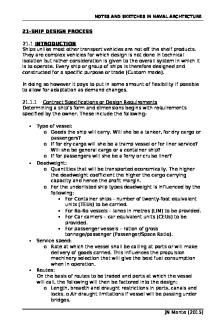
-Ship Design Process
- 1 Pages

Training design process of Nestle
- 13 Pages
Popular Institutions
- Tinajero National High School - Annex
- Politeknik Caltex Riau
- Yokohama City University
- SGT University
- University of Al-Qadisiyah
- Divine Word College of Vigan
- Techniek College Rotterdam
- Universidade de Santiago
- Universiti Teknologi MARA Cawangan Johor Kampus Pasir Gudang
- Poltekkes Kemenkes Yogyakarta
- Baguio City National High School
- Colegio san marcos
- preparatoria uno
- Centro de Bachillerato Tecnológico Industrial y de Servicios No. 107
- Dalian Maritime University
- Quang Trung Secondary School
- Colegio Tecnológico en Informática
- Corporación Regional de Educación Superior
- Grupo CEDVA
- Dar Al Uloom University
- Centro de Estudios Preuniversitarios de la Universidad Nacional de Ingeniería
- 上智大学
- Aakash International School, Nuna Majara
- San Felipe Neri Catholic School
- Kang Chiao International School - New Taipei City
- Misamis Occidental National High School
- Institución Educativa Escuela Normal Juan Ladrilleros
- Kolehiyo ng Pantukan
- Batanes State College
- Instituto Continental
- Sekolah Menengah Kejuruan Kesehatan Kaltara (Tarakan)
- Colegio de La Inmaculada Concepcion - Cebu


